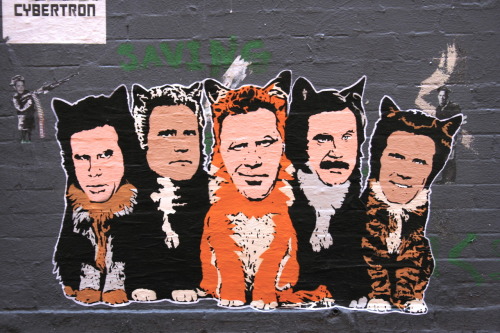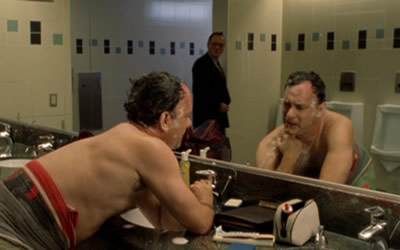 |
| An artwork by street artist Tom Hanksy (as in Tom Hanks + Banksy) |
Because of his pantheon of characters, Hanks' mythic presence reaches all types of people regardless of the genre preference, age, gender, and race. He appeals to everyone, allowing him to explore, perpetuate, or change New American Mythology with broader strokes than a single movie, show, or character could do on its own. People pay attention to what he does.
Which leads to the second point: Hank has the ability to influence New American Mythology's direction in the future. Hank has taken advantage of this through his recent roles which tend to convey a wholesome, positive message or somehow educate the audience. That is not to say his character in Philadelphia (Tristar Pictures, 1993) for example didn't do that. Rather, Hanks now seems to consciously create/seek roles that enlightens audience with morals or history. Specifically: Charlie Wilson's War (Universal, 2007), The Pacific* (Dreamworks SKG, HBO Films, 2010) as narrator and producer, Extremely Loud Incredibly Close* (Paramount Pictures, 2011), and Cloud Atlas* (Cloud Atlas Production Company, 2012). Of course, to fund such projects (and keep his status as mythic icons) Hanks still acts in movies like The Polar Express* (Castle Rock Entertainment, 2004) and Angels and Demons* (Columbia Pictures, 2009).
 |
| I found Polar Express to be on the edge of the uncanny valley. |
So what does this all really mean? Tom Hanks' work reveals New American Mythology as spanning the past, present, and future on multiple fronts, influencing how Americans see and react to the world around them. The following character analysis shows that Hanks chooses roles that emphasize that all individuals can succeed, no matter what skills they have.
An Astronaut,
Forrest Gump (Paramount Pictures, 1994) - Forrest is a Zombie in the best way possible. He lacks rationality, is unthinking, acts out of compulsion, and has no real need for purpose in life. All these things of course make him a great football player, soldier, ping-pong player, and runner. His selfless nature often puts him in dangerous and inadvisable situations while his impassive personality allows him to not be governed by traditional wants and desires (i.e. money, fame, sexual conquest, etc). He is a Zombie. No arguing.
Apollo 13 (Universal Pictures, 1995) - Jim Lovell is a real figure in American History. Tom Hanks/This movie turned him into a real figure in American Mythology. Lovell is the most Astronaut of astronauts to ever grace the silver screen. He is rational, empathetic, and calm throughout the movie, despite his dangerous situation. And, of course, he placed himself in a situation (going to the moon) that he knew could go very wrong, just to better American's knowlegdge/image.
[Tom Hanks doesn't really play Cowboy characters, with perhaps the exceptions of Jimmy Dugan in A League of Their Own (Columbia Pictures Corporation, 1992), Joe Fox in You've Got Mail (Warner Bros., 1998), and Michael Sullivan in Road to Perdition* (Dreamworks SKG, 2002). This trend continues in the 21st century, unless you want to count...]
Cast Away (Twentieth Century Fox Film Corp, 2000) - Chuck Noland whose journey transforms him from a Zombie to a Cowboy and/or Astronaut. He begins as a Zombie- focusing on his job to get money, despairing at his situation, and hoping someone else saves him. Eventually he learns that he must fend for himself, fight to live, like a proper Cowboy in a purgatory West. However, one could also argue that he is an Astronaut, living in isolation and relying only on himself to survive trying to find the truth of himself in purgatory West. Even the movie's end could be argued either way- is he a Cowboy living on his instincts, going wherever the wind blows him, or is he an Astronaut journeying into the great unknown, searching for the mysterious Truth.
 |
| Shenanigans in The Terminal |
I could do this all day with Hank's films. I could go in depth to every one of them (especially the Toy Story franchise), but there are so many it might get boring for you. However, feel free to leave your own observations, questions, and comments below.
With that I'll leave you with an Astronaut Tom Hanks quote:
"I love what I do for a living, it's the greatest job in the world, but you have to survive an awful lot of attention that you don't truly deserve and you have to live up to your professional responsibilities and I'm always trying to balance that with what is really important."
----------------------------------------------------
*I have not seen these movie, so my analysis may not be correct

No comments:
Post a Comment